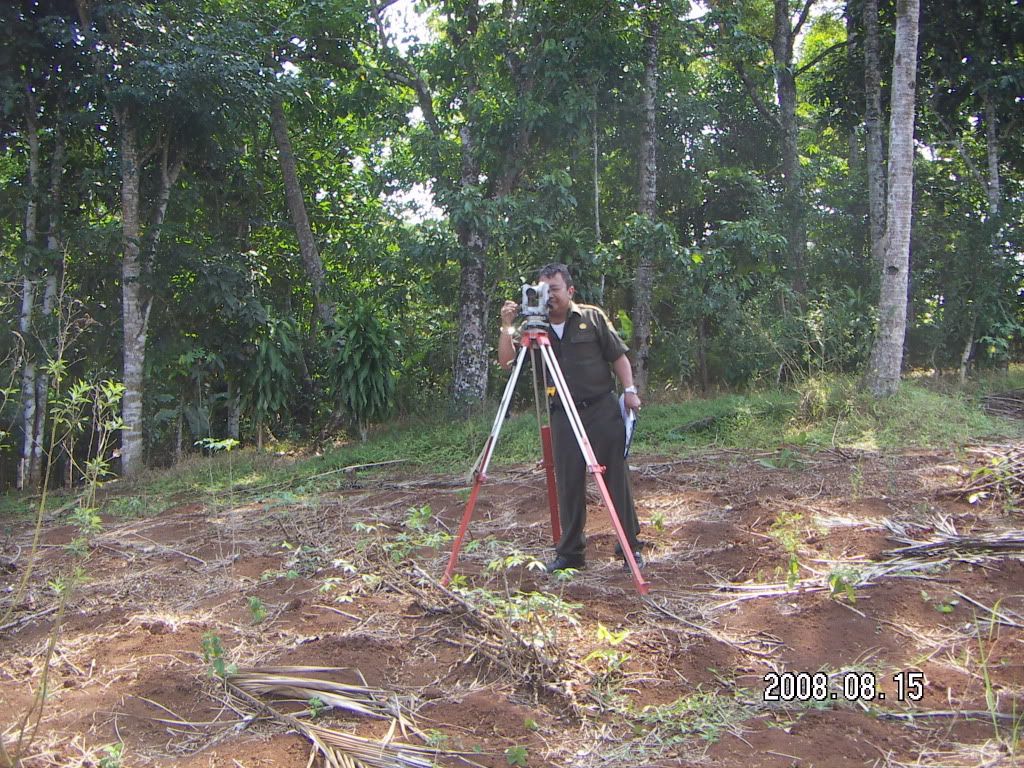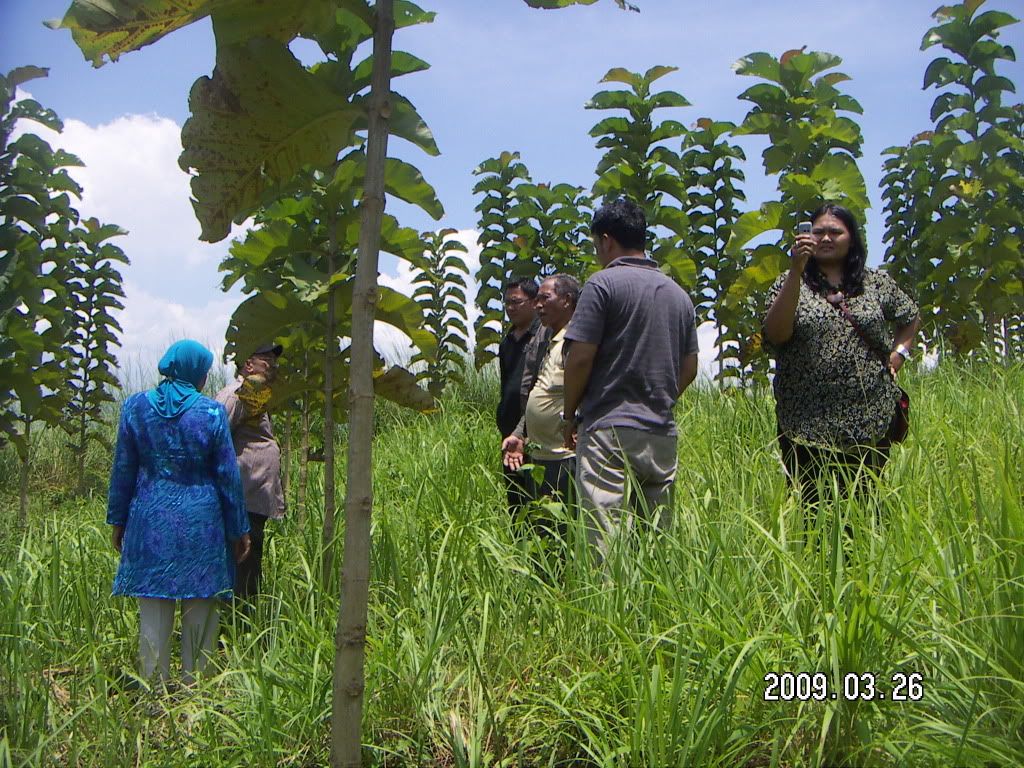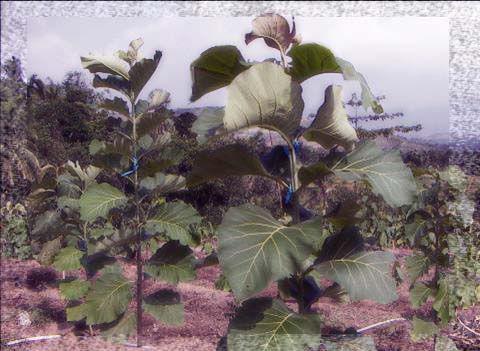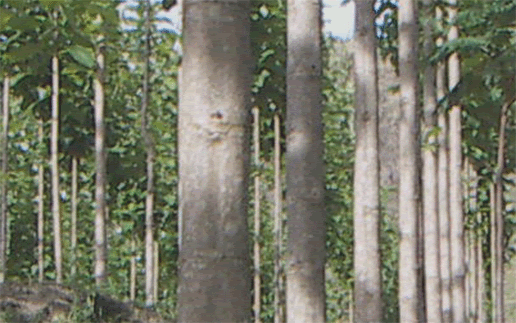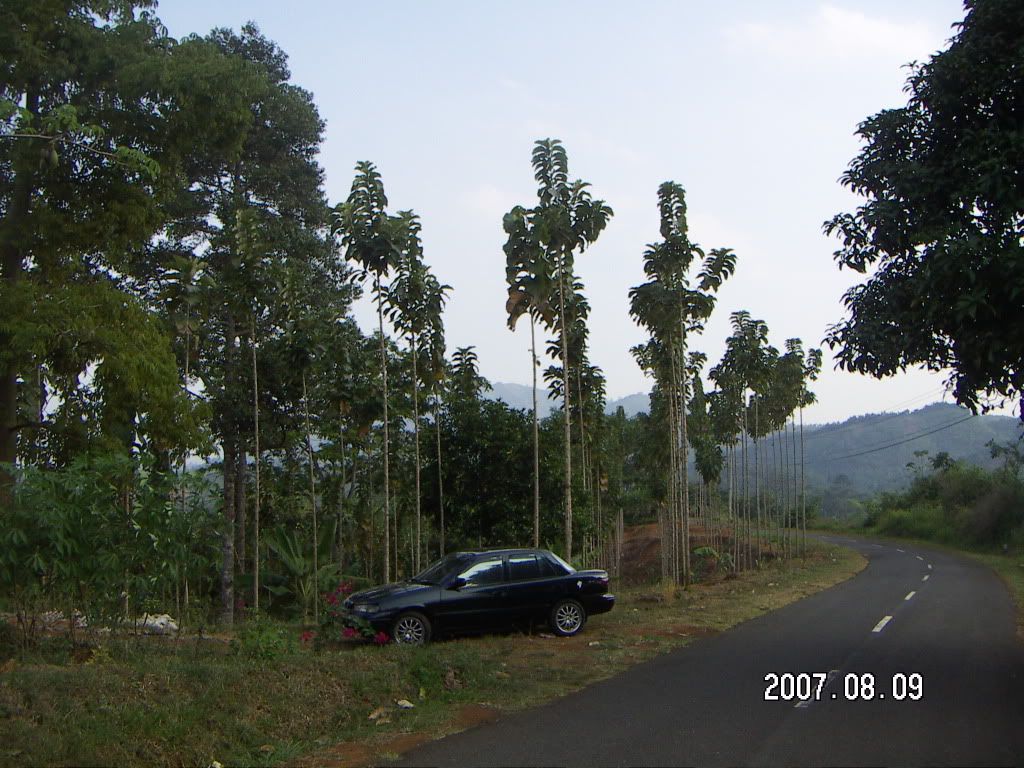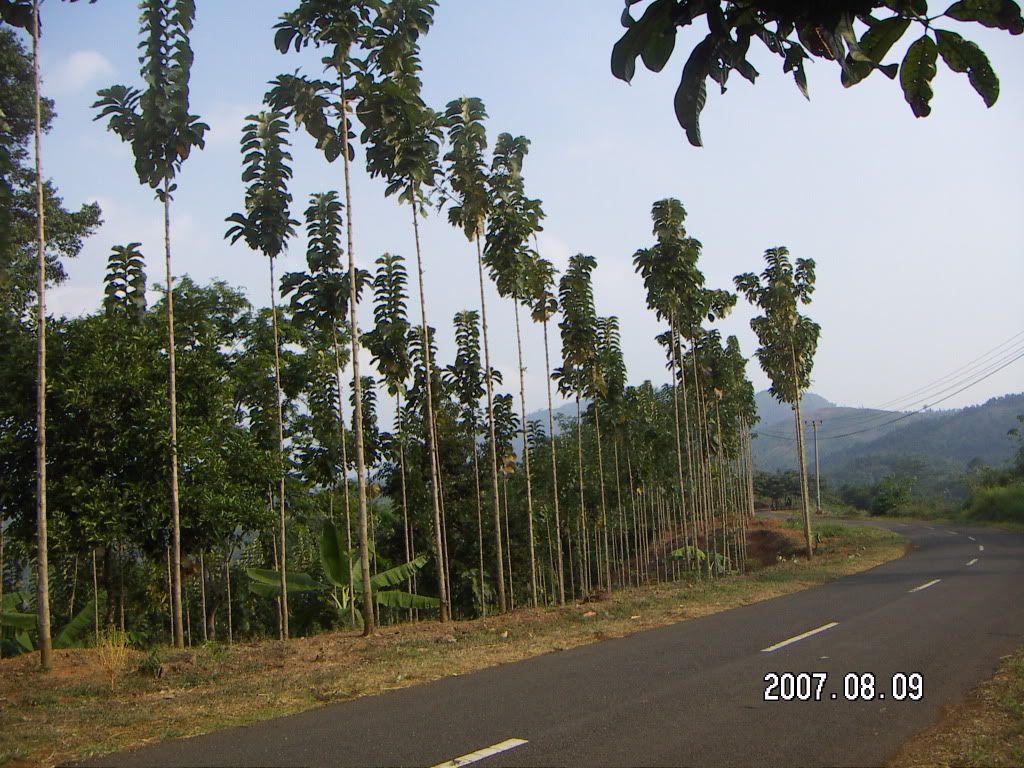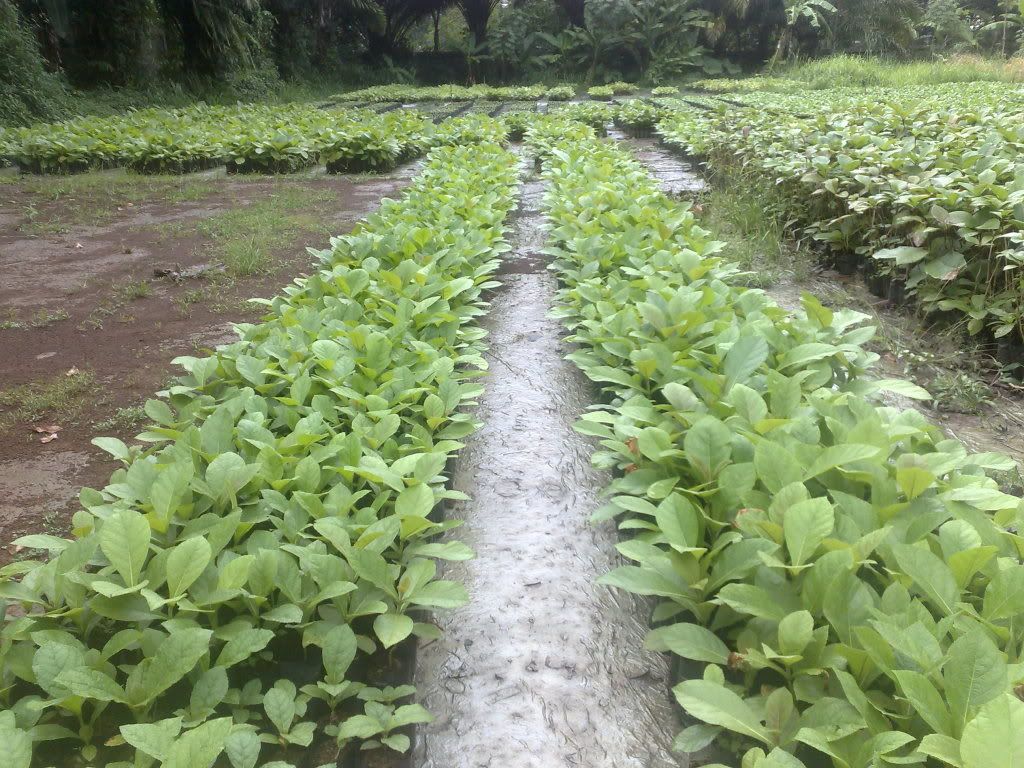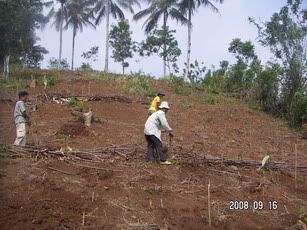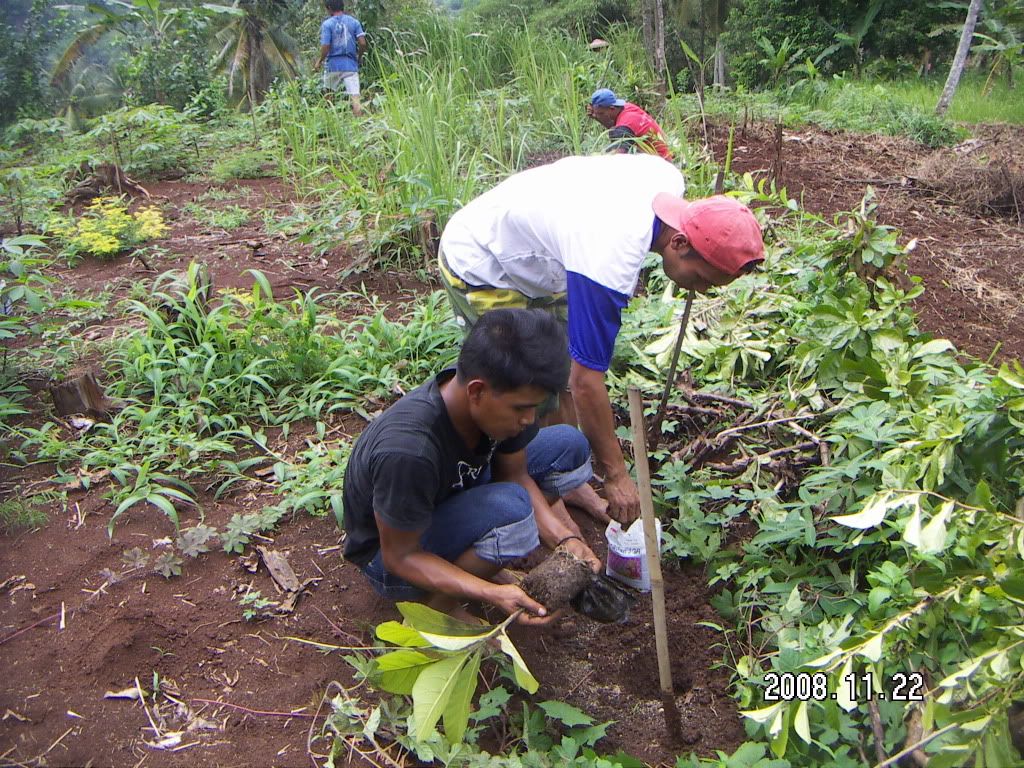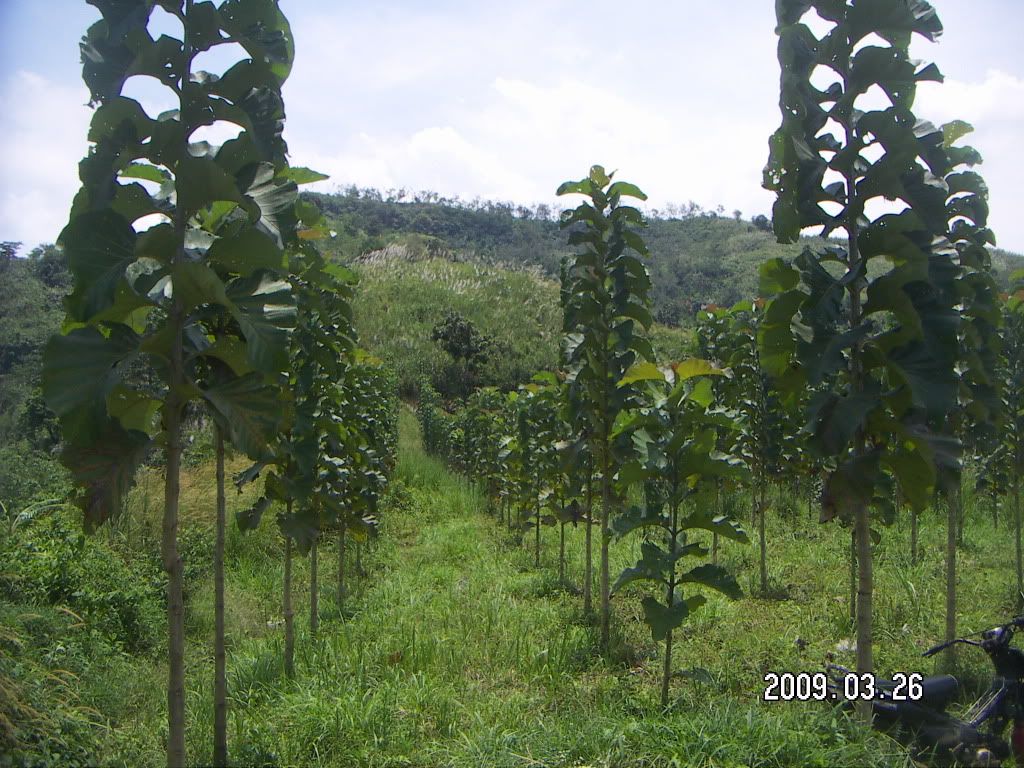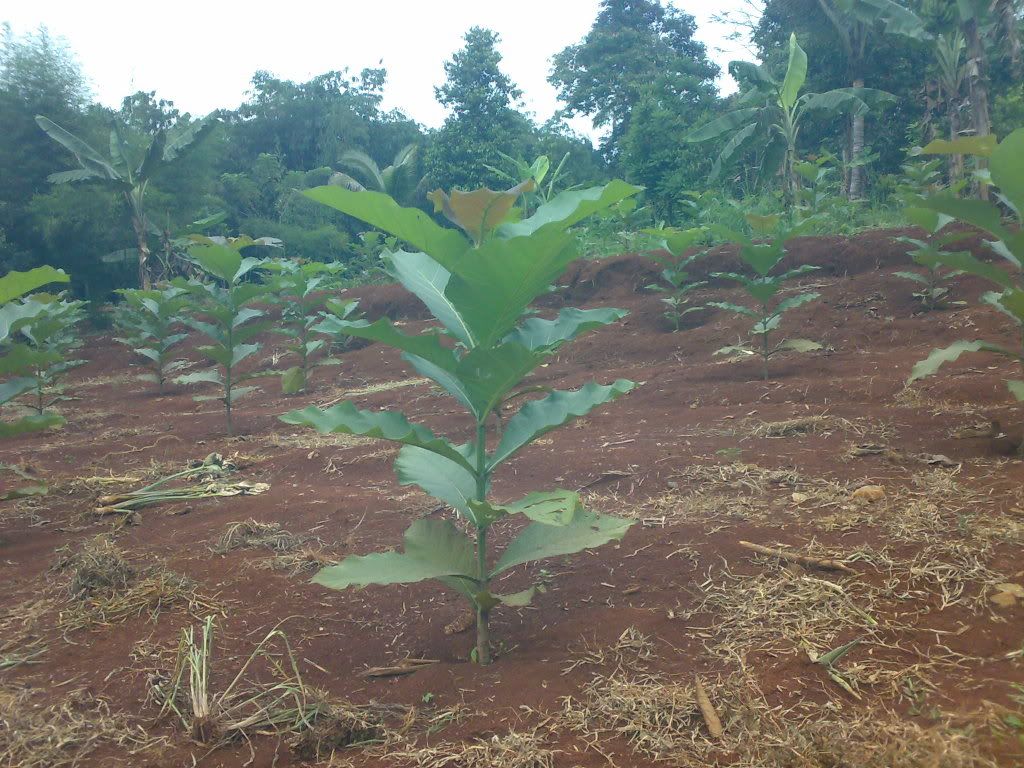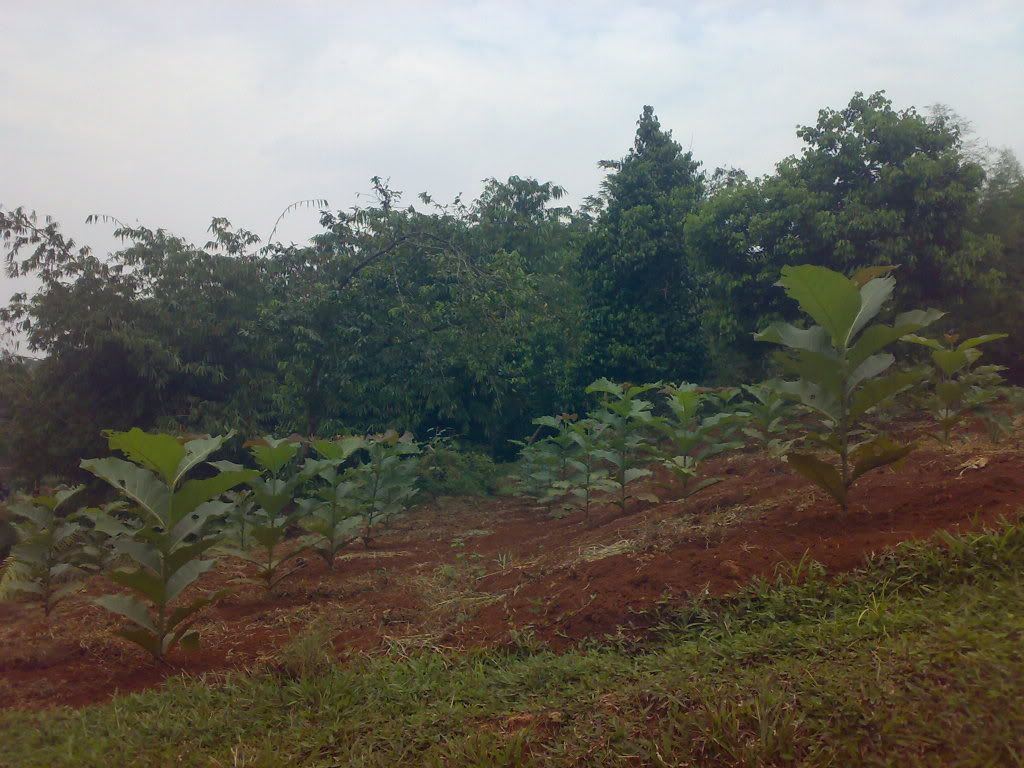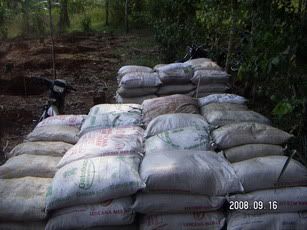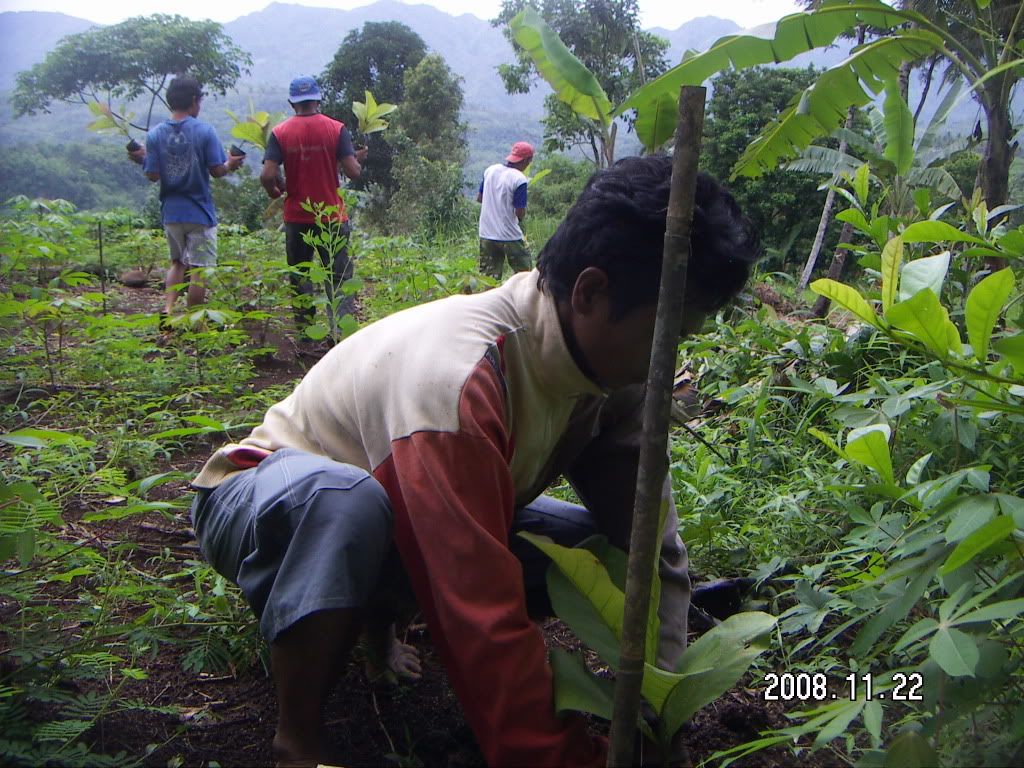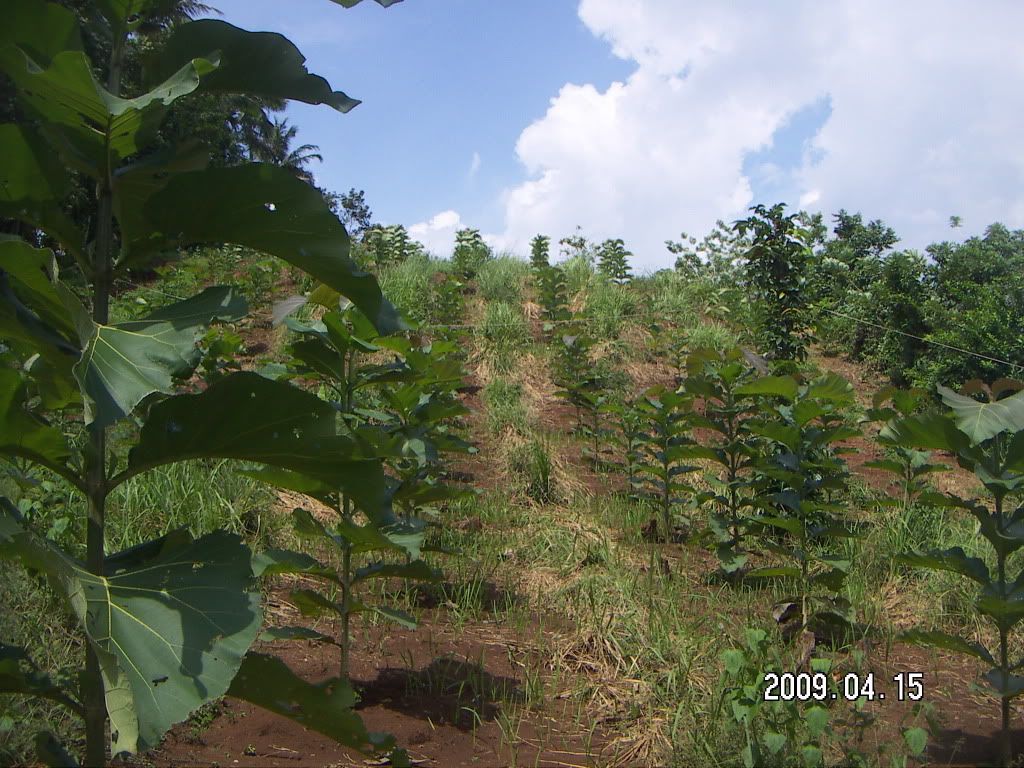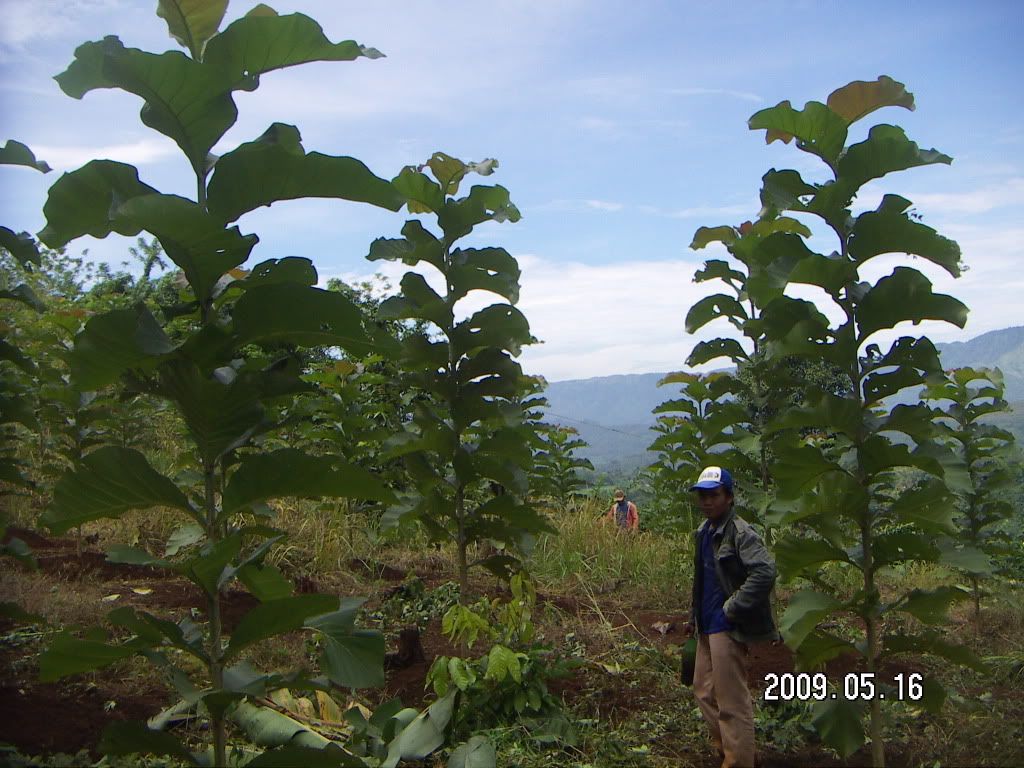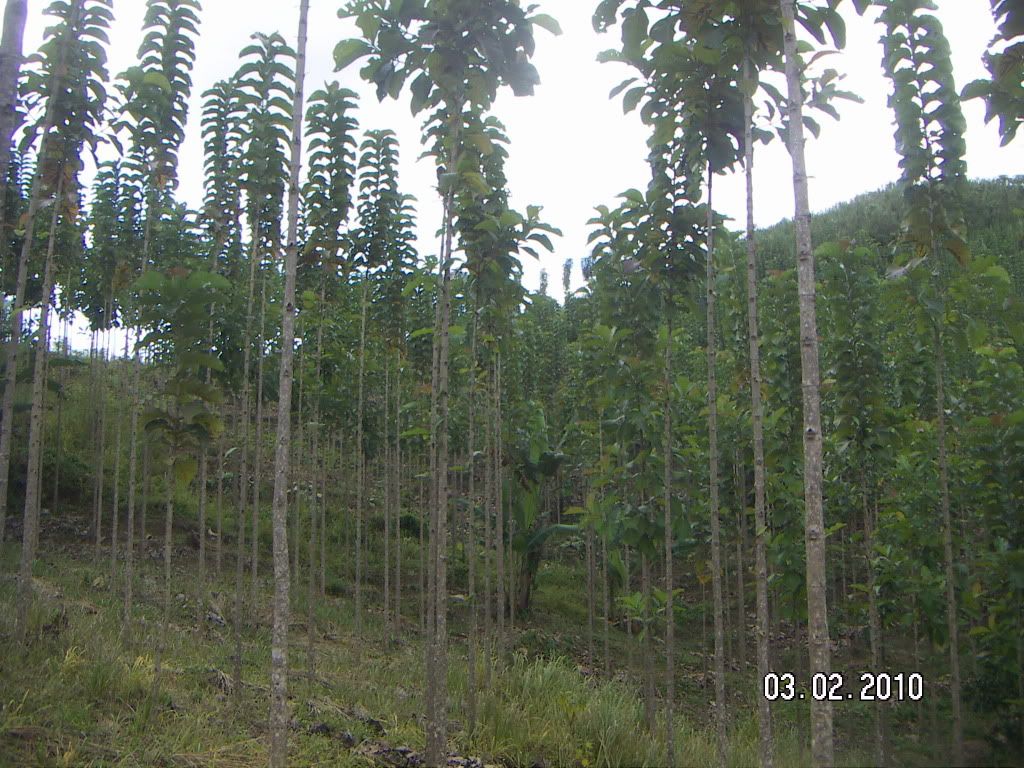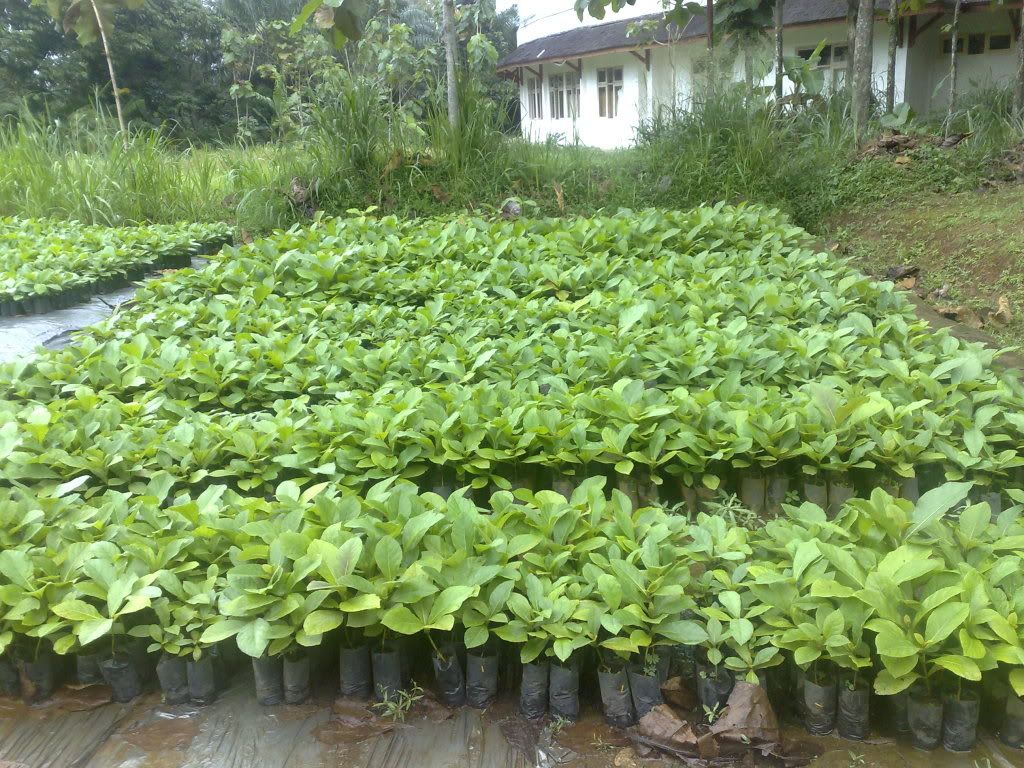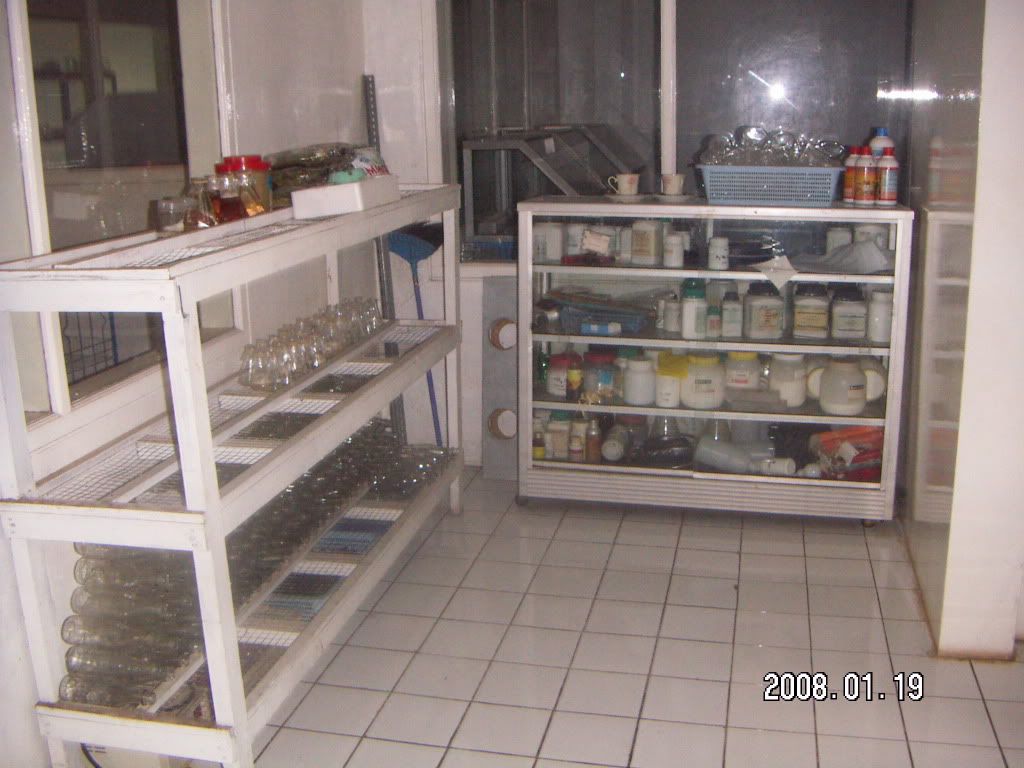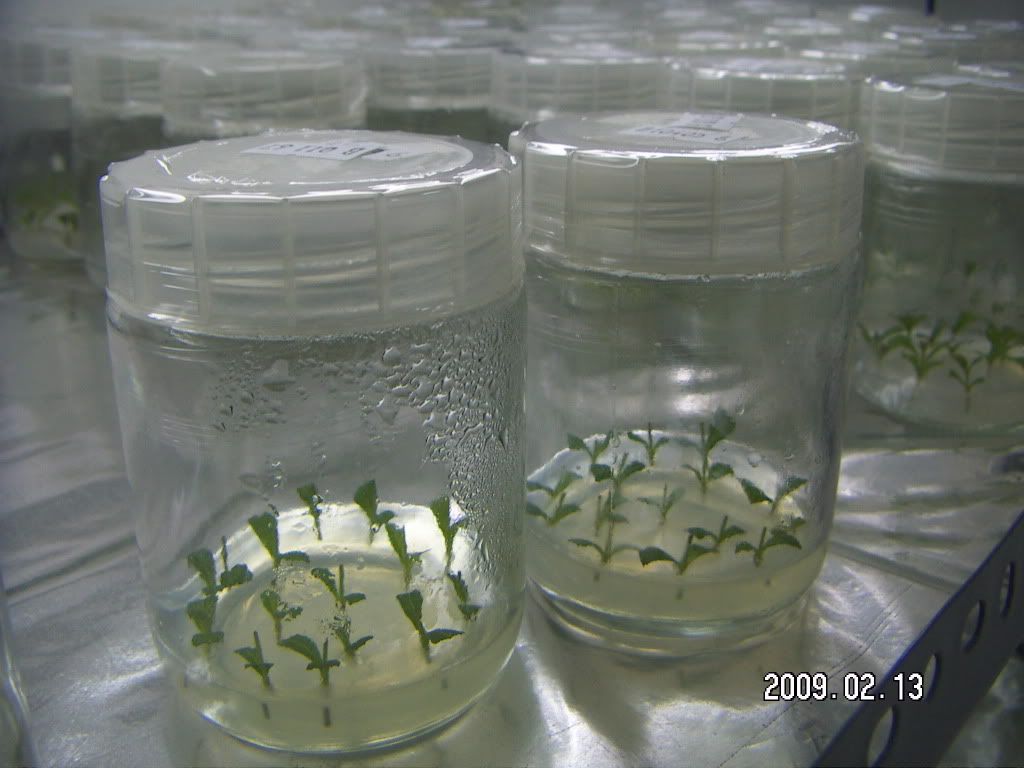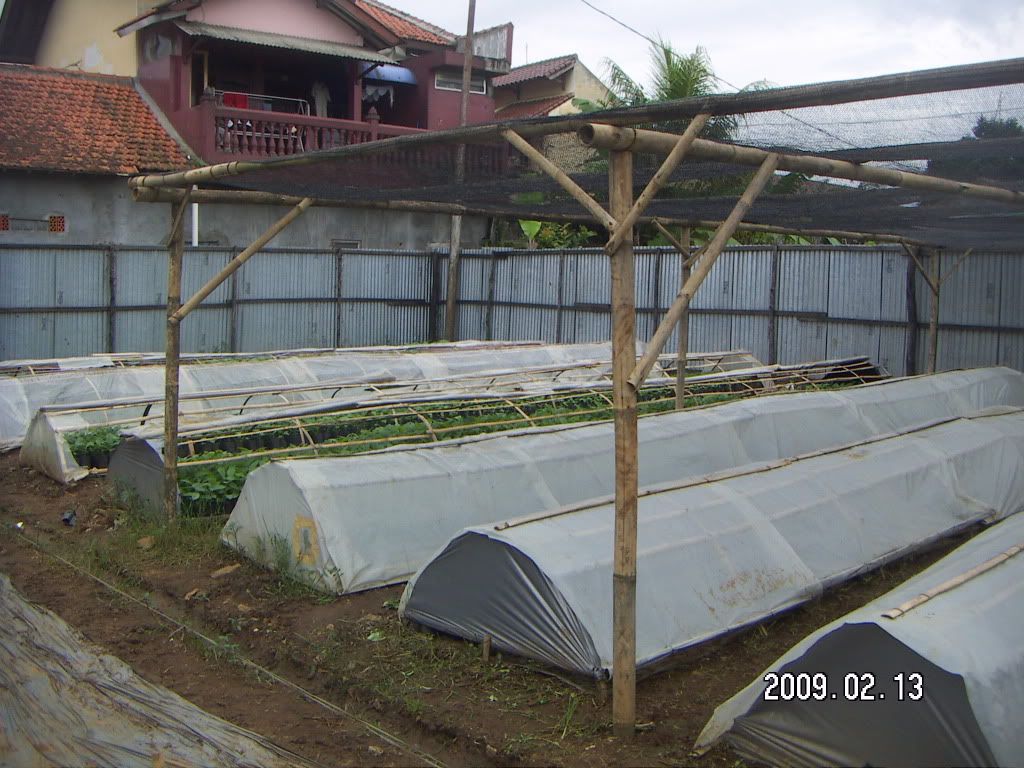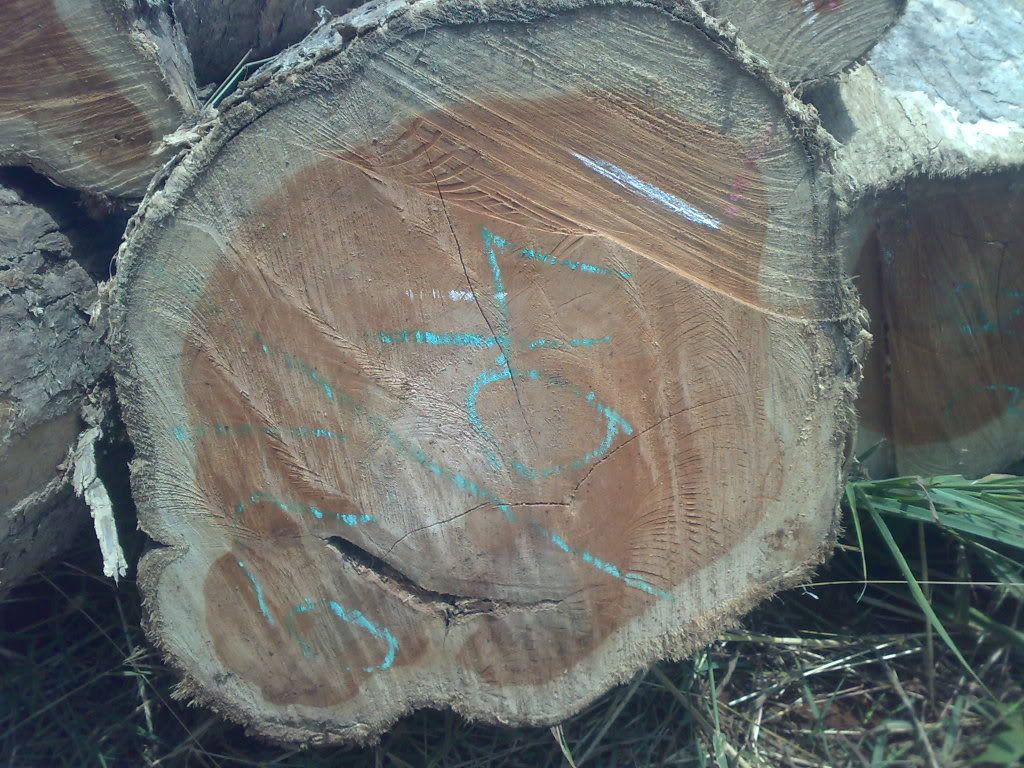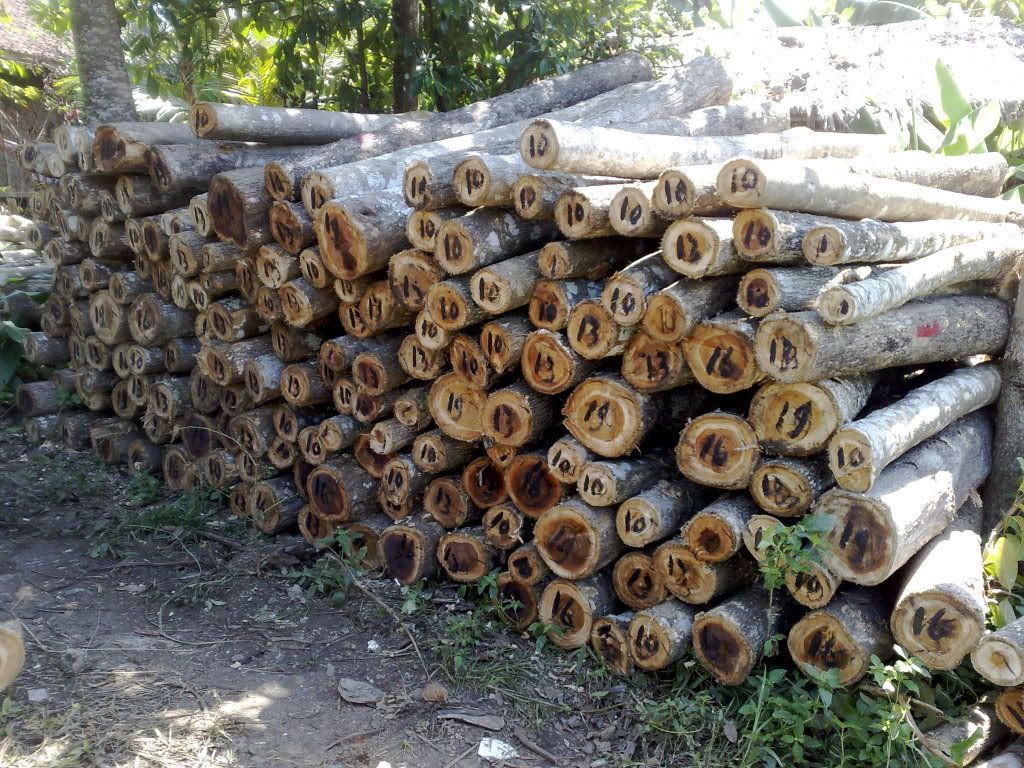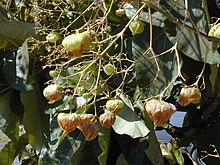About Teak Trees (wikipedia)
Teak
From Wikipedia, the free encyclopedia
Jump to: navigation, search
For the nuclear explosive test, see Hardtack Teak.
| ||||||||||||||||||||||||||
The name teak comes from the Malayalam[4] word Thekku.
Contents[hide] |
[edit] Systematics
Teak belongs to the family Lamiaceae (in older classifications in Verbenaceae). Sometimes it is included in the subfamily Prostantheroideae.[5] There are three species of Tectona:- Tectona grandis (Common Teak) is by far the most important, with a wide distribution in India and Indochina.
- Tectona hamiltoniana (Dahat Teak) is a local endemic species confined to Burma, where it is endangered.
- Tectona philippinensis (Philippine Teak) is endemic to the Philippines, and is also endangered.
[edit] Cultivation and uses
The yellowish brown timber with good grains and texture from teak trunk is used in the manufacture of outdoor furniture, boat decks, and other articles where weather resistance is desired. It is also used for indoor flooring and as a veneer for indoor furnishings.Teak, though easily worked, can cause severe blunting on edge tools because of the presence of silica in the wood. Teak's natural oils make it ideal for use in exposed locations and termite and pest proof, where it is durable even when not treated with oil or varnish. Timber cut from old Teak trees was once believed to be more durable and harder than plantation grown Teak. Studies have shown[6] plantation-grown teak performs on par with old-growth Teak in erosion rate, dimensional stability, warping, and surface checking.
Teak is used extensively in India to make doors and window frames, furniture and columns and beams in old type houses. It is very resistant to termite attacks. Mature teak fetches a very good price. It is grown extensively by forest departments of different states in forest areas.
Teak consumption encompasses a different set of environmental concerns, such as the disappearance of rare old-growth teak. However, its popularity has led to growth in sustainable production throughout the seasonally dry tropics in forestry plantations. The Forest Stewardship Council offers certification of sustainably grown and harvested teak products. Experiments are ongoing to achieve vegetative propagation from one year old stem cuttings.
Leaves of teak wood tree are used in making Pellakai gatti (jackfruit dumpling), where batter is poured in a teak leaf and is steamed.[citation needed] This type of usage is found in coastal districts of Dakshina Kannada and Udupi in state of Karnataka in India. The leaves are also used in gudeg, a dish of young jackfruit made in Central Java, Indonesia, and give the dish its dark brown color.
Teak is used as a food plant by the larvae of moths of the genus Endoclita including E. aroura, E. chalybeatus, E. damor, E. gmelina, E. malabaricus, E. sericeus and E. signifer and other Lepidoptera including Turnip Moth.
Hyblaea puera, an insect native to southeast Asia, is a teak pest whose caterpillar feeds on teak and other species of trees common in the region.[7] Much of the world's teak is exported by Indonesia and Myanmar. There is also a rapidly growing Plantation grown market in Central America (Costa Rica) and South America.
[edit] Propagation
Teak is propagated mainly from seeds. Germination of the seeds involves pretreatment to remove dormancy arising from the thick pericarp. Pretreatment involves alternate wetting and drying of the seed. The seeds are soaked in water for 12 hours and then spread to dry in the sun for 12 hours. This is repeated for 10–14 days and then the seeds are sown in shallow germination beds of coarse peat covered by sand. The seeds then germinate after 15 to 30 days.[8][9][edit] Gallery of Tectona grandis (Common Teak)
Insvestor Survey and...???
SURVEY LOKASI
 Biasanya ketika seseorang berminat untuk berinvest, sebelumnya dia mengirim e-mail kepada saya dan isinya menayakan beberapa hal seperti, dimana lokasi tanah tersebut, berapa jarak dari pusat kota (sukabumi), bagaimana kondisi tanah, berapa jarak dari lokasi ke jalan raya, bagai mana akses jalan, tanah, berbatu, aspal, dan juga bagai mana vasilitas air,listrik telepon dan sebagainya.
Biasanya ketika seseorang berminat untuk berinvest, sebelumnya dia mengirim e-mail kepada saya dan isinya menayakan beberapa hal seperti, dimana lokasi tanah tersebut, berapa jarak dari pusat kota (sukabumi), bagaimana kondisi tanah, berapa jarak dari lokasi ke jalan raya, bagai mana akses jalan, tanah, berbatu, aspal, dan juga bagai mana vasilitas air,listrik telepon dan sebagainya.Semua pertanya ini tentunya harus di jawab dengan jelas dan bijak sana, sebab jika kita kurang tepat dan kurang bijak dalam bembrikan jawaban bisa berakibat fatal pada kelangsungan negosiasi selanjutnya, nahkan bisa berakibat calon investor mengundurkan diri alias batal.
 Setealah semua terjawab selanjutnya terkadang calon insvestor yamg sudah merasa sangat tertarik atau mungkin merasa agak yakin, meminta diantar kelokasi tanah yang di tawarkan dan kemudian baru mereka berbicaramasalah keuntungan serta legalitas dan berbagai hal lainnya, tentunya semua terkadang tidak selancar yang dibayangkan, karena tak jarang
Setealah semua terjawab selanjutnya terkadang calon insvestor yamg sudah merasa sangat tertarik atau mungkin merasa agak yakin, meminta diantar kelokasi tanah yang di tawarkan dan kemudian baru mereka berbicaramasalah keuntungan serta legalitas dan berbagai hal lainnya, tentunya semua terkadang tidak selancar yang dibayangkan, karena tak jarang calon insvestor meminta kelokasi lainnya untuk mencari tempat atau lokasi tanah seperti yang diinginkan.
Baru setelah itu kesepakatan dilakukan dikantor atau melalui alat komunikasi yang biasa kita pakai saat ini seperti hand Phone dll, setelah itu barulah kita mengadakan pengadministrasian berupa pendaftaran, penandatangan persetujuan jual beli sampai pada pengukuran lokasi tanah yang akan di beli oleh investor tersebut yang dilakukan bersama sama antara penjual, pemberi dan pihak BPN sebagai badan yang berwenang atas pengukuran penerbitan Certivikat kepemilikan tanah.
PENGGALIAN LOBANG

 Setelah kedua pihak sepakat dan masuk pada pembayaran tahap pertama sebasar 40% dari total haga tanah tersebut, maka di mulailah proses selanjutnya, yaitu pengolahan tanah berupa pembersihan dan pembuatan lubang untuk penanaman bibit jati, yang dilanjutkan dengan penebaran pupuk pada setiap lobang yang dilakukan setelah lobang di diamkan menurut aturan yang telah ditentukan dalam ilmu bertani, semua dilakukan oleh belasan bahkan puluhan pekerja sesuai lahan yang akan di garaf, tentun saja para pekerja ini bukan para pekerja serabutan yang di ambil begitu saja dari perkampungan, akan tetapi memang pekerja yang telah terlatih dalam menangani penanaman jati khusunya jati Bioteak, mereka telah mendapat pelatihan khusus dalam peneneman bibit jati dan cara pengolahan tanah dalam penanaman pohon jati, hingga tetunya akan memperlancar dan mejamin hasil penanaman yang bagus dan sempurna, ini kami lakukan demi kepuasan para inspestor yang telah mengeluarkan biaya yang cukup besar untuk berinvestasi di perusahaan kami, baik lebih jelasnya kan kami jelaskan sebagai berikut. Setelah lahan bersih kami lakukan pengukuran jarak jati untuk di tanam. Jarak penanaman yang kami lakukan adalah 2 x 2 meter alasanya mengapa jaraknya harus 2 x 2 adalah saat jati tumbuh besar nanti jati ini kan tumbuh tinggi dan berdaun lebat, jika jarak penanaman dilakukan kurang dari 2x2 maka akan mengakibatkan pohon jati tumbuh terlalu berdekatan yang mengakibatkan terganggunya pembagian makanan dan udara pada masing masing pohon jati yang tentunya berpengaruh pada pertumbuhan pohon jati tersebut di kemudian hari, kami beritahukan bahwa setelah umur 5 tahun kedepan maka kebun jati ini akan menjadi sebuah area hutan jati yang rimbun dan leba. baik kita lanjutkan selanjutnya Tanah digali dengan ukuran lebar lubang adalah 40 x 40 cm dengan kedalaman 40 cm. lalu Tanah Bagian atas dicampur dengan kurang lebih 5 kg pupuk kandang dan diaduk-aduk sampai rata kemudian di kembalikan kebagian dasar lubang.
Setelah kedua pihak sepakat dan masuk pada pembayaran tahap pertama sebasar 40% dari total haga tanah tersebut, maka di mulailah proses selanjutnya, yaitu pengolahan tanah berupa pembersihan dan pembuatan lubang untuk penanaman bibit jati, yang dilanjutkan dengan penebaran pupuk pada setiap lobang yang dilakukan setelah lobang di diamkan menurut aturan yang telah ditentukan dalam ilmu bertani, semua dilakukan oleh belasan bahkan puluhan pekerja sesuai lahan yang akan di garaf, tentun saja para pekerja ini bukan para pekerja serabutan yang di ambil begitu saja dari perkampungan, akan tetapi memang pekerja yang telah terlatih dalam menangani penanaman jati khusunya jati Bioteak, mereka telah mendapat pelatihan khusus dalam peneneman bibit jati dan cara pengolahan tanah dalam penanaman pohon jati, hingga tetunya akan memperlancar dan mejamin hasil penanaman yang bagus dan sempurna, ini kami lakukan demi kepuasan para inspestor yang telah mengeluarkan biaya yang cukup besar untuk berinvestasi di perusahaan kami, baik lebih jelasnya kan kami jelaskan sebagai berikut. Setelah lahan bersih kami lakukan pengukuran jarak jati untuk di tanam. Jarak penanaman yang kami lakukan adalah 2 x 2 meter alasanya mengapa jaraknya harus 2 x 2 adalah saat jati tumbuh besar nanti jati ini kan tumbuh tinggi dan berdaun lebat, jika jarak penanaman dilakukan kurang dari 2x2 maka akan mengakibatkan pohon jati tumbuh terlalu berdekatan yang mengakibatkan terganggunya pembagian makanan dan udara pada masing masing pohon jati yang tentunya berpengaruh pada pertumbuhan pohon jati tersebut di kemudian hari, kami beritahukan bahwa setelah umur 5 tahun kedepan maka kebun jati ini akan menjadi sebuah area hutan jati yang rimbun dan leba. baik kita lanjutkan selanjutnya Tanah digali dengan ukuran lebar lubang adalah 40 x 40 cm dengan kedalaman 40 cm. lalu Tanah Bagian atas dicampur dengan kurang lebih 5 kg pupuk kandang dan diaduk-aduk sampai rata kemudian di kembalikan kebagian dasar lubang.PENANAMAN JATI BIOTEAK

 Tahap selamjutnya adalah tahap penanaman bibit jati, yang pertama-tama dilakukan adalah melepaskan polybag tanaman yang dilakukan dengan hati agar tidak terjadi kerusakan pada akar dan daun bibit jati yang tentunya bisa berpengaruh pada pertumbuhan bibit jati tersebut , kemudian bibit jati bioteak tersebut ditanam ditengah-tengah lubang yang telah dipersiapkan dengan posisi tegak lurus agar bibit jati tersebut tumbuh lurus tidak berleku-lekuk atau melengkung seperti busur panah, lalu tutup dengan tanah bagian bawah yang tidak tercampur apapun.
Tahap selamjutnya adalah tahap penanaman bibit jati, yang pertama-tama dilakukan adalah melepaskan polybag tanaman yang dilakukan dengan hati agar tidak terjadi kerusakan pada akar dan daun bibit jati yang tentunya bisa berpengaruh pada pertumbuhan bibit jati tersebut , kemudian bibit jati bioteak tersebut ditanam ditengah-tengah lubang yang telah dipersiapkan dengan posisi tegak lurus agar bibit jati tersebut tumbuh lurus tidak berleku-lekuk atau melengkung seperti busur panah, lalu tutup dengan tanah bagian bawah yang tidak tercampur apapun.PEMBERIAN VAKSIN
Vaksin yang telah diberikan oleh perusahaan dicampur dengan air, kemudian disiramkan pada tiap pohon jati yang baru ditanam. Usahakan vaksin yang telah dicampur air tersebut sampai kedalam tanah. Pemberian vaksin dilakukan setelah pohon jati ditanam antara 1 s.d 2 minggu.
PENYEMPROTAN HAMA
 Hama yang menyerang pohon jati yang kami alami adalah berupa ulat, belalang putih maupun rayap. Ulat menyerang pada pohon jati dibawah 1 tahun. Ulat menyerang daun dengan memakannya sampai dengan pucuk batang pohon jati. Biasanya ulat menyerang pada malam s.d. pagi hari. Maka dari itu kami sesering mungkin untuk melihat pohon jati, terutamanya pohon jati dibawah usia 1 tahun. Panembasian ulat selalu dilakukan dengan menyemprotkan pestisida, antaranya Decis, Buldog taupun Curacron.
Hama yang menyerang pohon jati yang kami alami adalah berupa ulat, belalang putih maupun rayap. Ulat menyerang pada pohon jati dibawah 1 tahun. Ulat menyerang daun dengan memakannya sampai dengan pucuk batang pohon jati. Biasanya ulat menyerang pada malam s.d. pagi hari. Maka dari itu kami sesering mungkin untuk melihat pohon jati, terutamanya pohon jati dibawah usia 1 tahun. Panembasian ulat selalu dilakukan dengan menyemprotkan pestisida, antaranya Decis, Buldog taupun Curacron.Menurut pengalaman penanan pohon Jati Bioteak atau istilah saya jati super grow ini pertumbuhannya lebih cepat ketimbang jati lokal lainya. Apalagi batang yang lurus menjulang keatas dan ditambah dengan daunnya yang lebar-lebar. Sehingga baru berumur 8 bulan saja, telah berdiameter 4 cm dengan catatan diberikan pupuk yang seusai aturan dan mendapat sinar matahari yang penuh.
Proses pemeliharaan setelah diatasn satu tahun tergolong mudah serta tidak menyita banyak waktu. Cukup dengan melakukan pengontrolan rutin agar terhindar dari ketidak suburan karena kurang pupuk atau ganggguan tangan-tangan jahil. Maklum, si kuat ini menjadi incaran banyak orang. Apalagi hutan makin gundul akibat pembalakan liar yang membuat stok kayu kian menipis dan berujung pada melambungnya harga kayu. Apalagi kayu jati sudah dikenal dengan kualitas dan ketahanannya tak perlu diragukan lagi. Kalau sudah begini, harapan menjadi jutawan bahkan milyader sudah berada dalam genggaman tangan Anda
JATI YANG SUDAH DIPANEN
 masa panen....ya inilah masa yang di nantikan setiap pemilik kebun jati, masa yang di nanti-nanti dan di impikan selama 10 tahun bahkan lebih, masa dimana seseorang akan tiba-tiba menjadi jutawan, bagaimana tidak, di saat sekarang saja harga kayu sudah mencapai 6 s/d 8 juta perkubik (untuk harga kayu saat ini bisa anda download di menu download diatas), coba kita bayang kan 10 tahun yang akan datang berapa harga kayu jati yang kian di cari banyak orang dan semakin langka ini, tentunya akan semakin membumbung tinggi, ya... pesimisnya harga kayu tetap seperti sekarang saja masih tetap membuat kita menjadi seorang jutawan mendadak.
masa panen....ya inilah masa yang di nantikan setiap pemilik kebun jati, masa yang di nanti-nanti dan di impikan selama 10 tahun bahkan lebih, masa dimana seseorang akan tiba-tiba menjadi jutawan, bagaimana tidak, di saat sekarang saja harga kayu sudah mencapai 6 s/d 8 juta perkubik (untuk harga kayu saat ini bisa anda download di menu download diatas), coba kita bayang kan 10 tahun yang akan datang berapa harga kayu jati yang kian di cari banyak orang dan semakin langka ini, tentunya akan semakin membumbung tinggi, ya... pesimisnya harga kayu tetap seperti sekarang saja masih tetap membuat kita menjadi seorang jutawan mendadak.Berikut contoh beberapa kebun yang kami kelola saat ini dan saat ini telah di panen, lokasinya di daerah Cipanca dan blok Cijati (blok ini dinamakan cijati setelah ada kebun jati yang kami kelola)
World’s Oldest Teak Trees in Trouble
By Toni and has no comments yet.
According to online reports from the spring of 2009, the two oldest known teak trees, located in Kerala, India are beginning to die. The famous flora duo is located on the Conolly plantation in the Malappuram district of Kerala in Southeast India. The trees are each about 163 years old, having been planted sometime between 1842-1844.
The plantation where the teaks reside is named after H.V. Conolly, the onetime Collector of Malabar during British colonial rule. He was said to have been an important figure in the planting of teak trees throughout the entire Nilambur area. Shri Chanthu Menon, a local forest officer working with Conolly on this venture, is also praised for his efforts. As a sign of respect, he is famously interred in Conolly’s plot on the plantation grounds.
In the teak garden, there exist a total of 117 trees, of which two have begun to show signs of decay, including the appearance of marked wrinkles, with some reports claiming that they are already 90% dead. Despite this tragedy, tourists are still allowed to visit the garden and gaze upon the bittersweet sight.
Teak has enjoyed a long and fruitful history as a valued building material for thousands of years. Used originally in the construction of structures and housing in its native Southeast Asia, it became popular in Europe after the British came upon the tree in their vast colonization of the area and brought the wood west, out of the monsoon forests and into temperate climes, where it became a staple of the iconic “English garden.”
Teak was also heavily used in the building of ship decks around this time because of its amazing strength, weather-resistant qualities and its ability to keep surrounding metal parts from rusting. From there, teak became synonymous with park benches throughout Europe, where some benches still around today date back some two centuries.
As the most popular wood choice in patio furniture, teak is not a newcomer to the world of outdoor entertainment, but it’s become the most profitable and well-known outlet as far as teak production. Sadly, the world’s oldest teak trees don’t have a bright future, but you can pay homage to the celebrated species in your own way. Owning a piece of teak furniture is not only a sound investment; it’s also like owning a little piece of history.
Read the original news report here: http://www.thaindian.com/newsportal/feature/worlds-oldest-teak-trees-dying-in-kerala_100191972.html#ixzz0f5DoYWuZCharacteristics of Teak Wood.
Teak is an extremely dense [40lbs cuft when dry] fine grained hardwood. Teak wood is generally straight grained, but occasionally wavy. The wood contains a high level of silica which causes rapid blunting of cutting edges.
When fresh cut the surface of the wood is dull in appearance, and the timber has a distinctive, pleasantly aromatic odor which has been likened to the smell of leather. Fresh sawn teak has a slightly 'oily' feel due to the high oil content.
One of the most commonly quoted facts about the characteristics of teak is its durability. It is resistant to rot caused by fungal decay, and the high level of resinous oil present in the timber helps to act as a natural insect repellent giving the timber very high resistance to attack by termites and other wood boring insects.
The timber is resistant to water and many chemical reagents, including acids. It does not have a strong reaction when it comes in contact with metals.
The life time in the open for untreated wood (no varnish, lacquer, paint or polishing) is 30 – 35 years.
When fresh cut the surface of the wood is dull in appearance, and the timber has a distinctive, pleasantly aromatic odor which has been likened to the smell of leather. Fresh sawn teak has a slightly 'oily' feel due to the high oil content.
One of the most commonly quoted facts about the characteristics of teak is its durability. It is resistant to rot caused by fungal decay, and the high level of resinous oil present in the timber helps to act as a natural insect repellent giving the timber very high resistance to attack by termites and other wood boring insects.
The timber is resistant to water and many chemical reagents, including acids. It does not have a strong reaction when it comes in contact with metals.
The life time in the open for untreated wood (no varnish, lacquer, paint or polishing) is 30 – 35 years.
Care and Maintenance of Teak Furniture
Teak is a naturally beautiful wood with rich grain and color ranging from a honey gold to a chocolate brown. The grain and color come from the growth rings, and no two pieces will be alike in grain or color.It is best to receive your teak furniture in its “natural” finish (not oiled or waxed). This way you can tell the quality of the teak, and have a choice of finishes. Some manufacturers oil or polyurethane their teak furniture. This may be done to hide blemishes, and make the furniture look more attractive.
Natural Finish (Weathering)
If Teak is left unfinished, then it will weather to a handsome silvery gray. This process is gradual and usually takes between three to twelve months, depending on sunlight exposure. Rain or water will not affect the process. However, you may get some water spots when the teak is first exposed to the elements. You may choose to clean them out with mild soap and water, or leave them be. Either way, in a few months time, the furniture will be uniformly gray.
If teak furniture is exposed to rain, its grain will lift slightly. This is a natural process as wood slightly expands and contracts with the wet ad dry cycles. It will not affect the strength or durability of the wood. Teak will return to its smooth feel after the initial weathering process.
Teak Oil Finish
Teak Oil may be applied to Teak outdoor furniture to extend the aesthetic appearance of the new teak furniture. Teak oil, or other finishes that protect from Ultraviolet Light bleaching, delay the bleaching of the wood as long as they are effective. These finishes in no way extend the life of the furniture. Teak furniture requires no treatment to protect the wood.
Teak Oil eventually evaporates in six to twelve months (based on area conditions and sun exposure). You will notice that the oil finish starts showing a few streaks of unoiled wood. At this time, you must reapply teak oil to preserve the color.
If teak oil treatment is not repeated, the furniture will eventually bleach to a silvery gray.
Polyurethane Finish
Poly Urethane is used to finish teak wood panels on boats. This is only to maintain its aesthetic color, and give it a smooth shine. Teak wood does not require any finish to preserve its strength.
The Polyurethane will eventually flake and peel. Boatyards usually apply three coats of polyurethane onto teak trim used in boats annually.
Grades of Teak Furniture
Teak furniture is made from teak wood, and is manufactured by several methods. It is important to understand the grades of wood, the process for the wood, and the manufacturing process.
Teak Wood is graded by appearance, knots (and their location) and by the kind of wood. There are three main grades in teak wood.
Teak Wood is graded by appearance, knots (and their location) and by the kind of wood. There are three main grades in teak wood.
Grade A Teak wood is produced from the center of the tree (commonly known as the 'heart' wood). A grade A piece of teak will be produced from a tree from 30-50 years of age.
characteristics: close grain, warm/honey color, oil rich and knot free. No streaks of white, no knots on top side, very few (live knots only – where there is discoloration but no fill – on the underside) knots, and these knots have to be less than 0.5 inch in diameter, and present only once in every 3-4 linear feet. This kind of wood is used in machine made teak furniture, since it is risky for the manufacturer to allow a cottage industry person to play with expensive, high quality wood and expect mediocre to bad results.
Grade B Teak wood has a warm color with occasional streaks of black and some splotches and discoloration. Grade B teak wood has more allowance for knots per linear feet. Grade B teak wood is sometimes used in “semi machine made” product. Semi Machine Made implies that personnel use electric saws to cut the wood, but there is no concept of a jig and fixture to make all the slats the same size or make the process repeatable. Semi Machine made product does not allow the end consumer the luxury of finding a replacement part, since all parts are unique and made to fit a specific piece. Semi machine made also means that the tenons “float” in the mortices (the joint is not exact, and there are gaps). This is usually filled with epoxy, and generally the furniture comes completely assembled, because the end customer would not tolerate the sloppiness.
Grade C Teak Wood has a dark color in places, mixed with a very white color in places. The white is the young sapwood. There is an allowance for dead knots (where the knot was weak, has been gouged out and filled with epoxy or putty) These knots may be on the top side or the bottom side. Grade C teak wood is most often used in “hand crafted” outdoor teak furniture. This is completely outsourced to the village industry and follows no process for drying and manufacture. Hand crafted also means that the tenons “float” in the mortices (the joint is not exact, and there are gaps). This is usually filled with epoxy, and generally the furniture comes completely assembled.
In summary – Grade A teak wood will most likely be machine made. Grade B and C will most likely be “semi machine made” or “hand crafted”.
Manufacturing
Machine made makes the parts precise and interoperable. This implies that if a part on your chair or table breaks, you can get a like replacement.
Semi Machine made furniture is a cheaper method of manufacture, more prone to error, and every piece is unique, with little possibility of replacing parts exactly
“Hand Made” – means everything in that piece of furniture was made without jigs and fixtures, and that there is a wide variation between items, plus the incidence and danger of warping (mainly in the legs).
So, in conclusion – Grade A teak combined with Machine made production and kiln drying (not air drying) offers the best furniture.
USES OF TEAK WOOD
Teak wood is often used in marine applications, boatbuilding, Outdoor and indoor furniture and flooring.
High quality Teak can be imported from Asia. Color and grain pattern will vary--making your piece uniquely wonderful.
Teak is a very durable hardwood with excellent split resistance.
Often chosen for its beautiful olive-brown or yellow-brown color which will become more golden as time progresses. Density is 45 pounds per cubic foot.
When and Why to Choose Teak Wood for your project
When choosing a wood species for a project (say garden furniture), it is critical that you define the requirements.
Your requirements and constraints could be:
Environment (Outdoors, salt air etc.)
Good Natural color
Good Weathered Color
High Resistance to Decay
High Resistance to boring insects like carpenter ants and termites
High Resistance to checking and splitting
High Resistance to splintering
High Strength (requires less bulky sections)
If your requirements were as stated above then the choice of teak is very good as it offers low shrinking and swelling, good color with age, natural decay resistance, natural oils that repel water, and good strength. Honduran mahogany is also reasonable, as it provides most of the needed properties. However, Honduran Mahogany does shrink and swell with wetting and drying more than teak, so some checking and splitting can be expected.
Note: There are three wood species (not related and with considerably different properties) that we call mahogany--African, Honduran, and Philippine mahogany.
Of our native American species, we don't have one that stands out as being fully acceptable. Most softwoods are not suitable due to resin exudation or their low strength. Old growth cypress is one possibility. Many hardwoods are prone to checking or are very low in strength. Woods like black locust or Osage orange, which are good candidates, are hard to find, machine with some difficulty, and have high enough shrinkage to cause concern about splits. Walnut is a strong possibility, but when wet it might leach a little, causing a person's white pants to become discolored if they sat on wet furniture; same problem with Osage orange. (American chestnut would be a good candidate too; lumber is still available.)
| |||||||||
| Home | About Us | Client Portfolio | Request a Catalog | Shipping | Popular Searches Contact Us | Customer Service | FAQs | Security and Privacy | Shipping For questions or assistance, e-mail us or call 800-289-8325. Monday - Thursday 9am-5:30pm ET / Fridays 9am-5:00pm ET ©2010 Country Casual | |||||
